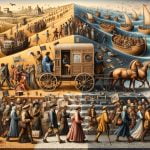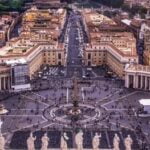Medieval German traveling artists in Italy played a significant role in the cultural exchange between Germany and Italy during the medieval period. These artists, often referred to as “journeymen,” ventured to Italy from various regions of Germany, bringing with them their unique artistic styles and techniques. In this article, we will explore the impact of these traveling artists on Italian society and art, as well as the influences, challenges, patronage, and legacies associated with their presence in Italy.
During the Middle Ages, German traveling artists journeyed to Italy seeking inspiration, knowledge, and opportunities to showcase their talents. This migration of artists led to a rich cultural exchange between the two regions. The influx of German artists into Italy not only contributed to the development of Italian Renaissance art but also had a lasting impact on German artistic traditions.
As we delve into the topic of medieval German traveling artists in Italy, we will examine their role in Italian society and how they navigated the challenges and obstacles they faced. Additionally, we will explore the influence of Italian art and culture on these German artists, as well as the patronage and support they received from Italian nobility. By understanding this historical exchange, we can gain insight into the enduring cultural relationship between medieval German and Italian artists.
The Role of Medieval German Artists in Italian Society
Integration Into Italian Art Scene
During the medieval period, Italy was a hub for artistic and cultural exchange, attracting artists from all over Europe, including the German territories. These traveling artists played a significant role in the Italian art scene, bringing their unique styles and techniques to the forefront. Many German artists found themselves assimilating into Italian society, collaborating with local artists and receiving commissions from Italian patrons.
Contributions to Local Artistic Communities
Medieval German traveling artists in Italy made valuable contributions to the local artistic communities. Their presence not only enriched the diversity of artistic expression, but also fostered a cross-pollination of ideas and techniques. German artists brought with them the influence of Gothic art and craft traditions, which merged with the flourishing Italian Renaissance movement, leading to new forms of artistic innovation.
Cultural Exchange and Mutual Influence
The interaction between German artists and Italian society was a two-way street, with each influencing the other in profound ways. While German artists were influenced by the rich artistic heritage and classical influences of Italy, they also left their mark on Italian art by introducing elements of Northern European style and iconography. This cultural exchange laid the groundwork for a lasting impact on both German and Italian art for centuries to come.
Influences
Artistic Styles and Techniques
Italian art and culture had a profound impact on medieval German traveling artists in Italy, particularly in terms of artistic styles and techniques. The vibrant and dynamic nature of Italian art, characterized by its emphasis on naturalism, perspective, and humanism, inspired German artists to incorporate similar elements into their own work.
The influence of Italian Renaissance artists such as Giotto, Donatello, and Masaccio can be seen in the works of German painters and sculptors who traveled to Italy during this period.
Subject Matter and Themes
In addition to stylistic influences, Italian art also impacted the subject matter and themes explored by medieval German artists. The rich mythology, classical stories, and religious narratives depicted in Italian art served as a source of inspiration for German artists seeking to broaden their creative horizons. The exposure to Italian culture allowed German artists to explore new themes such as the classical gods and goddesses, ancient heroes, and biblical figures, which added depth and diversity to their artistic repertoire.
Cultural Exchange
Beyond the realm of art itself, the influence of Italian culture on medieval German traveling artists in Italy extended to their overall worldview and perspective. The experience of living and working in Italy exposed German artists to new ideas, philosophies, and ways of life that enriched their understanding of the world.
This cultural exchange fostered a greater sense of cosmopolitanism among German artists and contributed to the cross-pollination of artistic ideas between Germany and Italy. Overall, the impact of Italian art and culture on medieval German traveling artists was significant in shaping the trajectory of European art history.
Patronage and Support
The relationship between medieval German traveling artists in Italy and the Italian nobility was crucial for the success and influence of these artists in Italian society. As they journeyed to Italy, German artists often relied on the patronage and support of Italian nobles to fund their work and provide them with opportunities for artistic growth.
This section will explore the dynamic between these artists and Italian nobility, shedding light on how this relationship shaped the cultural exchange between Germany and Italy during the medieval period.
Many German artists found themselves welcomed by Italian noble families who were enthusiastic about commissioning artworks that reflected the emerging Renaissance style. The Medici family in Florence, for example, played a significant role in supporting German artists such as Albrecht Dürer, providing them with not only financial backing but also access to influential connections within Italian artistic circles.
This patronage allowed German artists to immerse themselves in Italian art and culture, ultimately contributing to the fusion of German and Italian artistic techniques.
One of the challenges faced by medieval German traveling artists in Italy was the language barrier, as many of them did not speak fluent Italian. However, the support of Italian nobility often included providing translators or intermediaries who facilitated communication between the artists and their patrons.
Additionally, through their relationships with Italian nobles, German artists gained access to prestigious workshops and studios where they were able to refine their skills and learn from renowned Italian masters. This exchange of knowledge and experiences contributed to the cross-pollination of artistic styles between Germany and Italy during this period.
| German Artists | Italian Nobility |
|---|---|
| Albrecht Dürer | The Medici Family |
| Matthias Grünewald | The Sforza Family |
Techniques and Innovations
During the medieval period, German traveling artists made a significant impact on Italian Renaissance art through their unique techniques and innovations. These artists brought with them a blend of their German artistic traditions and influences from their experiences in Italy, ultimately contributing to the rich tapestry of the Italian Renaissance.
Some of the ways in which German artists contributed to Italian Renaissance art include:
1. Woodcut Printing: German artists were known for their expertise in woodcut printing, a technique they brought with them to Italy. This innovation allowed for the mass production of images and texts, thereby expanding the reach and accessibility of art during the Renaissance.
2. Sculptural Techniques: German sculptors also played a crucial role in shaping Italian Renaissance art through their mastery of sculptural techniques. The influence of German sculptors is evident in works such as the Tomb of Ilaria del Carretto by Jacopo della Quercia, showcasing intricate detailing and expressive forms.
3. Northern Realism: The naturalistic style favored by many German artists influenced Italian painters, leading to a greater emphasis on detail and realism in their work. This exchange of artistic styles resulted in a fusion of Northern European and Italian artistic traditions, contributing to the evolution of Renaissance art.
The exchange between medieval German traveling artists in Italy and local Italian artists led to a cross-pollination of ideas that enriched both artistic traditions. As a result, German artists left an indelible mark on Italian Renaissance art, leaving behind a legacy that continues to be studied and admired today.
Challenges and Obstacles Faced by Medieval German Traveling Artists in Italy
Medieval German traveling artists in Italy faced numerous challenges and obstacles as they ventured into a new and unfamiliar artistic landscape. From language barriers to cultural differences, these artists had to navigate various difficulties in order to establish themselves and gain recognition in Italian society. Some of the key challenges that these artists encountered include:
1. Language and Communication: One of the primary obstacles for medieval German traveling artists in Italy was the language barrier. Most German artists were not fluent in Italian, making it difficult for them to communicate with potential patrons or understand the local customs and traditions.
2. Cultural Adaptation: The difference in cultural norms between Germany and Italy posed a significant challenge for traveling artists. They had to adapt to a new social environment, as well as adjust their artistic style to align with the preferences of Italian audiences.
3. Competition with Local Artists: In Italy, medieval German traveling artists faced stiff competition from established local artists who already had strong ties with Italian nobility and patrons. This made it challenging for German artists to secure commissions and opportunities to showcase their work.
Despite these obstacles, many medieval German traveling artists still managed to leave a lasting impact on Italian art through their perseverance, innovation, and adaptation to the new cultural milieu. These challenges influenced their artistic development and contributed to the unique fusion of German and Italian artistic styles during the Renaissance period.
Legacy and Impact
The legacy and impact of medieval German traveling artists in Italy is significant and enduring. These artists played a crucial role in shaping the artistic landscape of Italy during the medieval period, leaving behind a lasting influence that can still be seen in Italian art today. The presence of German artists in Italy brought about a cultural exchange that enriched both German and Italian artistic traditions.
One of the most notable contributions of medieval German traveling artists in Italy was their introduction of new techniques and innovations that deeply influenced Italian Renaissance art. The exchange of artistic knowledge between Germany and Italy led to the development of new styles and approaches, creating a fusion of artistic traditions that transformed the course of European art history.
The use of oil painting, an innovation brought by German artists, revolutionized Italian art and paved the way for the masterpieces of the Renaissance.
Furthermore, the patronage and support of Italian nobility played a pivotal role in enabling the success and influence of medieval German traveling artists in Italy. Wealthy patrons recognized the unique perspective and skills that German artists brought to Italian soil, providing them with opportunities to create magnificent works of art that left a lasting impact on Italian art history. This patronage not only contributed to the flourishing careers of German artists but also facilitated cultural exchange between Germany and Italy.
Lastly, the challenges and obstacles faced by medieval German traveling artists in Italy must not be overlooked when discussing their legacy and impact. Overcoming language barriers, adapting to unfamiliar customs, and navigating a foreign landscape were just some of the many hurdles these artists encountered. Despite these challenges, they managed to leave behind a rich legacy that continues to inspire contemporary artists across Europe.
| Medieval German Traveling Artists | Legacy and Impact |
|---|---|
| Influenced Italian Renaissance art | Introducing new techniques |
| Received patronage from Italian nobility | Fostered cultural exchange |
| Faced challenges in foreign land | Left enduring influence on European art |
Conclusion
In conclusion, the enduring cultural exchange between medieval German traveling artists in Italy had a profound impact on both German and Italian art. The influence of German artists on Italian society was significant, as they brought new techniques and innovations that contributed to the development of Italian Renaissance art. Additionally, the patronage and support from Italian nobility played a crucial role in facilitating the presence of German artists in Italy.
The legacy and impact of medieval German traveling artists in Italy can still be seen today in the lasting influence they left on Italian art. The integration of German techniques and innovations into Italian art has shaped the artistic landscape of both countries, creating a rich tapestry of cultural exchange and collaboration.
Despite the challenges and obstacles faced by these artists, their contributions to Italian art and culture cannot be understated. The enduring cultural exchange between medieval German and Italian artists continues to be a testament to the power of artistic collaboration and cross-cultural influences.
Frequently Asked Questions
Which German Artist Was Greatly Influenced by Italy?
The German artist who was greatly influenced by Italy was Albrecht Dürer. His visit to Italy had a significant impact on his work, and he incorporated Italian artistic techniques and styles into his own art.
Who Was a German Painter Who Used Techniques of the Italian Renaissance?
Albrecht Dürer, a German painter, was known for using techniques of the Italian Renaissance in his artwork. He studied and adopted the principles of perspective, proportion, and anatomy from Italian artists, which had a lasting influence on his paintings.
What Popular German Artist Helped Spread Renaissance Styles?
Lucas Cranach the Elder, a popular German artist, played a key role in spreading Renaissance styles in Germany. His works reflected the influence of Italian Renaissance art, particularly in terms of classical motifs and humanist themes that were prevalent during the time period.

I’m a passionate traveler, writer, and Italophile. My fascination with Italy’s history, art, and culture has led me on countless adventures across the Italian landscape. Through “I Live Italy,” I share my love for this extraordinary country and aims to inspire others to explore its boundless beauty.





